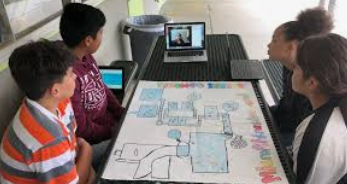Smart Learning Techniques for Collaborative Learning
Smart Learning Techniques for Collaborative Learning
Liu, H., Wu, A., & Zhou, Q
Abstract:
Education is a lifelong activity, and the internet now enables various smart learning techniques. Smart education refers to the use of the internet and information technology to promote more effective and efficient education processes. This paper addresses various smart learning techniques that can enhance student learning and outcomes. The paper also reviews previous research on smart education to decipher the developmental status of smart education and provide theoretical and academic application suggestions. Smart education includes intelligent teaching, smart campuses, multimedia teaching, and remote learning, among others. This paper explores various new techniques for their effectiveness and proposes some novel techniques that could enhance student learning based on smart education. The paper analyses three different datasets and implements four machine learning classification algorithms for this purpose.
Keywords: Education, Smart Education, Student Learning, Student Outcome, Machine Learning
- Introduction
COVID-19 Pandemic facilitates the development of online courses on a large scale. As a supplementary teaching in a special period, online courses play a gratifying role in enabling students to learn repeatedly and master effectively. However, it cannot be ignored that there are still some problems, and we need to find better solutions. This article takes the “Artificial Intelligence” course as an example, through a set of data analysis, puts forward the improvement plan of the network course, and discusses the “before and after class” teaching mode in blended learning. Through this way we could have a glimpse of the future education, which makes full use of online courses and uses online courses as an icing on the cake for traditional classrooms. The Covid-19 has caused a great impact on China’s education. As practitioners in the education sector, we continue to pay attention to this impact and hope to contribute to China’s education. Coincidentally, in early April, we received an invitation from Professor Naveeda Khan of JHU to make a simple statement and summary of the impact on the education in China as part of her upcoming collection of the influence of the epidemic on global education. Under such an opportunity, we wrote this article. We hope that this article will give people an objective understanding of the impact of the novel corona virus on Chinese education.
With the rapid development of science and technology, the change of “Internet +”, cloud computing, cloud storage and other new generation of information technology makes the information highly circulating, travel and daily life are very convenient, and Big data is the product of the current era. Education as a continuation of thousands of years of behavior, how to comply with the times? How to exploit the intrinsic value of big data? There is also a broader space for thinking and development. The essence of intelligent education lies in the analysis of the current mainstream education model, the combination of specific education behaviors, the analysis of the mutual integration of big data and education, the promotion of the integration and development of education of big data.
The sudden outbreak of the novel corona virus, Covid-19, brought a lot of loss to China and the Chinese people. To contain the epidemic, people had to stay where they were. They could not go back to work or to school. Some dormitories in the universities were requisitioned temporarily as ward for Covid-19-infectious patient. The offline courses were due many reasons infeasible, what brought unexpected changes to education. With the analysis on the latest news about policies and relevant data, this paper focuses on the impact of the epidemic caused by Covid-19 on the education in China. In order to make the influence clearly and comprehensive, the education in China is divided into varies of parts, namely, compulsory education, extracurricular education and higher education, which further divided into study abroad and study inland. And the influence concentrates on the teaching and learning-effect, the transformation of the teaching forms, the employment of the students and the enrollment of the schools. The analysis result shows that the compulsory education is the less affected than higher education, because the students who are taking compulsory education do not face the employment pressure. Although online courses are lack of supervision, so that the learning effect of the students with poor self-control will get worse and the gap between good students and bad students will widen, after they return to school and take the normal offline courses, the “Matthew Effect” will be eliminated. In comparison, the employment and enrollment stress that the students and universities are suffering from will last for a long time. Besides, the extracurricular education also encounter irreversible loss, because companies that incapable to open online courses are forced to close. In addition, problems of the online courses platforms are found through the research. Professional teaching platforms are still a blank and urged to be developed. In a word, despite all the impact on the Chinese education, education sector is still an optimistic area because of the hope and potential brought and presented by the online education.
Education is a lifelong cause, which is worthy of struggling for. Education can set up a strong barrier for the development of a country. Whether in compulsory education, university or lifelong education, there is no end to learning. We must set up a concept of lifelong education and make full use of the advantages of the Internet so as to innovate the concept as well
The rest of the papers was organized as follows: section 2 shows the related literature review, section 3 discusses about the various data sets used for the experiments followed by data visualization in section 4. Section 5 and section 6 presents the various experiments conducted and the tabulated results and discussion. Section 7 concludes the work.
- Literature Review
The authors in this paper, (1) focused on the impact of the epidemic caused by COVID-19 on the education in china. To discuss the clear and comprehensive influence, authors divided the Chinese education into namely compulsory education, extracurricular education and higher education which further divided into study abroad and study inland. The authors also focused on the influence concentrates on the teaching and learning-effect, the transformation of the teaching forms, the employment of the students and the enrolment of the schools. Further, the authors analysis shows that the compulsory education is the less affected than higher education, because the students who are taking compulsory education do not face the employment pressure. Although online courses are lack of supervision, so that the learning effect of the students with poor self-control will get worse and the gap between good students and bad students will widen, after they return to school.
In this paper, (2) authors aim to explore how to use information technology to build online teaching systems for Art & Design subjects to train related talents under the pandemic. Due to COVID-19 pandemic, remote education became a mandatory for all types of education in the world including Arts and Design subjects. Students and the faculty have used to utilize the Information technology platforms that allow administrator to prepare courseware and deliver real-time courses, enable teacher-student interaction as human-computer interaction. The Video conferencing software was used for the virtual class room where the students and the teacher interaction was made available. Video conferencing software like Zoom, Google classroom are used by the students and teachers. Author also discussed about the new education models like student-oriented and teacher-guided teaching model.
The authors, (3) carried out a Systematic Literature Review to define the relevant studies involving the CeLT construction. They observed that the computational approaches are in continual progression and many of researchers proposed diverse clustering algorithms based on, or integrated, with the k-means algorithm. Then, they focused on to discover the added values of ACO bio-inspired as an emergent solution for grouping problems. According to their findings, it is clear that there are other approaches that are becoming increasingly used for grouping problems. Consequently, authors focused on studies involving the ideas of heuristics that are inspired by the intelligent behavior of ants when they are organizing their nests. Therefore, according to the data synthesis, authors have selected, adapted and simulated an improved ant clustering algorithm. This work was a good starting point for future works on a real smart education environment.
The authors, (4) attempted to implement a voice control based education companion robot for primary education aiming at providing better service of accompanying and puzzle for primary school students. The authors used Raspberry Pi as the core processor to control the voice functionalities. The voice was realized by communication between Arduino and Raspberrry PI, while the voice question-answer was implemented in the form of client server architecture based on the voice recognition module.
The authors (5) discussed on the Online software service based on SaaS which was a newly emerged software application mode and also one of the common cloud computing modes. Authors proposed an Online learning platform based on Saas mode, being practical, universally applicable, flexible and extendable, transformed online education from traditional products into service, which could greatly reduce software and hardware and thereby better serve the remote continuing education in our schools. Authors discussed on the Status quo of continuing higher education in China and problems related to the remote continuing education platform. Further, analyzed the advantages of SaaS remote continuing education platform and its implementation.
The authors expressed that, (6) COVID-19 Pandemic forced people working in many industries around the world to revaluate existing models and develop new forms of business under the premise of adopting to the current from such as education. The Online teaching supported by the integration of a variety of new technologies has been valued, which has also promoted the accelerated realization of blended learning and the innovation of new teaching models. As an alternative to conventional mode of teaching during pandemic period, online courses played an important role in enabling students to learn repeatedly and master effectively. However, there are several problems which cannot be ignored. In this article, authors took Artificial Intelligence course as an example to discuss about the before and after class teaching mode. In this article, authors tried to show the mode of future education which makes use of Online courses effectively.
In this paper, (7) authors addressed the effort to transform an innovation into economic goods and new organization by combining entrepreneurial engineering education and project based design for optimal results. Authors proposed a seven step project-based design learning model and presented that the proposed model can be successfully integrated with principles of entrepreneurship that prepare students for establishing new firm or can be strong contributors to innovative startups. The proposed structured seven steps include project definition, Brainstorming, Research, Design, Modeling, Testing and Delivery.
It was observed that (8), artificial intelligence is received increasing attentin within the field of developing smart digital education. Researchers are using Computational Intelligence (CI) and machine learning techniques methodologies to develop a smart tutoring systems. Also the convergence of AI, data science and Internet of Things (IoT) enabled the creation of a new generation of web-based smart systems for all educational and learning tasks. The authors in this paper discussed about the CI and knowledge engineering paradigms for developing the smart educational and learning systems. The main objective of their study is to determine and explore the benefits and advantages of such intelligent paradigms to increase the effectiveness. This paper also addressed the challenges faced by the application developers and knowledge engineers in developing and deploying such systems.
The authors (9) presented a constructive concept for engineering education for non-technical students. This attempt was an innovative concept to teach fundamentals of engineering to non-engineering students and implemented the same. The limitations of this study were the small number of students and lack of quantitative evaluation. The aim of this paper is to share the idea of teaching and learning concept to non-technical students within the engineering education and research. Authors proposed this novel theory based teaching and learning concept of a bachelor engineering course to non-engineering students. The study was conducted with an innovative project based laboratory experiments and evaluated the trail run with the experimental platform.
In India, (10) NBA accreditation to all the engineering colleges was mandated. Project based learning is considered as one of the efficient ways as it blends theoretical and practical learning. In this paper, authors illustrated implementation of project based learning activity. As a case study, an experiment was carried out with the group of students studying in third-year mechanical and Electronics & Telecommunication engineering. As part of evaluation, different interdisciplinary projects were assigned to both discipline students. The study results proved that the project-based learning improves performance of the students.
Education is a lifelong cause, (11) which is worthy of struggling for. Education can set up a strong barrier for the development of a country. Whether in compulsory education, university or lifelong education, there is no end to learning. We must set up a concept of lifelong education and make full use of the advantages of the Internet so as to innovate the concept as well as model of lifelong education. In this paper, authors discussed to establish the qualification framework and a lifelong learning system and bigdata information platform for lifelong education business.
The authors, (12) designed a computer hardware composition course and conducted the effect research based on the teaching mode of intelligent learning environment. They used big data technology and intelligent algorithms to analyze each learner, which provided personalized learning service for students. It is noticed that, Autonomous learning and knowledge feedback based on augmented reality technology have better captured the characteristics of learners and brought them into an efficient learning environment. Also, the freshness brought by emerging technologies is one of the highlights of this lesson. Undergraduates’ study time is relatively relaxed and free. Further, the authors want to combine augmented reality technology to study whether students are still willing to learn in ubiquitous learning, that is, informal learning. Authors suggested the researchers to constantly think, practice, and innovate according to the actual teaching.
The authors, (13) provided a comprehensive overview of the research and application of smart education from the main seven branches of smart education namely, Intelligent Tutoring System (ITS), Smart campus, Big Data in Education, Knowledge graph, educational robots, virtual teachers and personalized education. Authors after deep literature review and market research proposed the development of smart education based on the status of smart education development. Authors also presented about the Big Data in Education and its application on educational data mining and learning analytics. Authors concluded that smart education has shown a dynamic progress in both academic research and practical application with rich product.
- Materials and Methods
Datasets: As part of data collection activity, we have explored various data sources available for the educational data and found few from online resources as useful for our data survey through data visualization and then create models on the educational data.
For our analysis, we have collected 3 different datasets, one with the education data among all the countries, the second dataset is the online class room evaluation posts dataset and finally the student performance dataset. The detailed columns in each of the above 3 tables are discussed below tables.
The following are the 3 datasets we used for our analysis.
- Education data set
- Online class posts data sets
- Student performance dataset
The data dictionary of Student Performance dataset
| S.No | Column | Count (#) | Data type |
| 1 | Gender | 480 | Object |
| 2 | NationaliTy | 480 | Object |
| 3 | PlaceofBirth | 480 | Object |
| 4 | StageID | 480 | Object |
| 5 | GradeID | 480 | Object |
| 6 | Topic | 480 | Object |
| 7 | SectionID | 480 | Object |
| 8 | Semester | 480 | Object |
| 9 | Relation | 480 | Object |
| 10 | Raisedhands | 480 | Int64 |
| 11 | VisiTedResources | 480 | Int64 |
| 12 | AnnouncementsView | 480 | Int64 |
| 13 | Discussion | 480 | Int64 |
| 14 | ParentAnsweringSurvey | 480 | Object |
| 15 | ParentschoolSatisfaction | 480 | Object |
| 16 | StudentAbsenceDays | 480 | Object |
| 17 | Class | 480 | Object |
The data dictionary of education data by country
| S.No | Column | Count (#) | Data type |
| 1 | Country | 15312 | Object |
| 2 | Date | 15312 | Int64 |
| 3 | GNP | 6277 | Float64 |
| 4 | Population | 15147 | Float64 |
| 5 | Edu_prime | 6441 | Float64 |
| 6 | Edu_second | 870 | Float64 |
| 7 | Edu_post_second | 790 | Float64 |
| 8 | Edu_lower_second | 979 | Float64 |
| 9 | Unemp | 1692 | Float64 |
| 10 | C_code | 10556 | object |
Data dictionary of Online class posts dataset.
| S.No | Column | Count (#) | Data type |
| 1 | Unnamed: 0 | 71 | Float64 |
| 2 | total_posts | 71 | Float64 |
| 3 | helpful_post | 71 | Float64 |
| 4 | nice_code_post | 71 | Float64 |
| 5 | collaborative_post | 71 | Float64 |
| 6 | confused_post | 71 | Float64 |
| 7 | creative_post | 71 | Float64 |
| 8 | Bad_post | 71 | Float64 |
| 9 | Amazing_post | 71 | Float64 |
| 10 | timeonline | 71 | Int64 |
| 11 | Sk1_classroom | 71 | Object |
| 12 | Sk2_classroom | 71 | Object |
| 13 | Sk3_classroom | 71 | Object |
| 14 | Sk4_classroom | 71 | Object |
| 15 | Sk5_classroom | 71 | Object |
| 16 | Approved | 71 | Int64 |
- Experiments
In our student performance dataset, we have a binary target variable which takes 2 values either 0 or 1. For our experiments to predict the parentschool satisfaction either positive or negative, we have explored various machine learning algorithms. Machine learning can be defined as a field of study that assigns a class label and algorithms are designed to predict the target values for the given dependent values. There are various types of machine learning algorithms like classification, clustering, regression etc. Classification is a task that requires the use of machine learning algorithms that learn how to assign a class label to examples from the problem domain. Using classification, we can solve the problems like checking email as spam o not, predicting whether the patients has the disease or not provided the symptoms of the payment.
We have evaluated various methods to conduct the experiments like using weka tool, Matlab tools etc. But, in our experiments we used python packages like Numpy, pandas, matplotlib, seaborn etc. Matplotlib and Seaborn packages are used to visualize the dataset.
In our problem, we have picked top performing classification algorithms and experimented with the pre-processed data. The following are the algorithms that will be discussed
- XGBoost Classifier
- Decision Tree Classifier
- Random Forest Classifier
- Gradient Boosting Classifier
The results of the above experiments along with the classification metrics for both training and testing data along with their confusion matrix will be discussed in next section.
- Results and Discussions
Classification metrics:
Precision
| Algorithm | Training | Testing |
| XGBClassifier | 0.9016 | 0.7714 |
| GradientBoostingClassifier | 0.9404 | 0.75 |
| DecisionTreeClassifier | 1 | 0.7368 |
| RandomForestClassifier | 0.9956 | 0.7794 |
Recall
| Algorithm | Training | Testing |
| XGBClassifier | 0.9523 | 0.8852 |
| GradientBoostingClassifier | 0.9567 | 0.8852 |
| DecisionTreeClassifier | 0.9913 | 0.6885 |
| RandomForestClassifier | 0.9956 | 0.8688 |
Accuracy
| Algorithm | Training | Testing |
| XGBClassifier | 0.9088 | 0.7604 |
| GradientBoostingClassifier | 0.9345 | 0.7395 |
| DecisionTreeClassifier | 0.9947 | 0.6458 |
| RandomForestClassifier | 0.9947 | 0.7604 |
- Conclusion
In this study we have collected 3 different types of datasets to do analysis and survey on the education datasets. The datasets and the descriptive fields are described in the materials and methods section. Using the student performance dataset in analysis, we analyzed the parentSchoolSatisfaction as target variable. As the target variable has two values, we tried to fit the best binary classifier algorithm. For our analysis, we have conducted experiments in python environment using Jupyter notebooks. The scikit learn python packages is used to evaluate various machine learning models after data pre-processing. For our analysis, we picked 4 top performing classifier models ie., XGBoost classifier, Gradient boosting classifier, Decision tree classifier, Random forest classifier. From the experiments, we identified that tree-based classifier models, Random forest gave an accuracy of 99.52% with training data and 78.23% with test data. From the results it was evident that the model was suffering with overtraining as it gave good accuracy during training. The main reason for this could be little data and unbalanced data for the given target variable. The graphs in the results and discussion section show the comparison graph of precision, recall and accuracy respectively.
Acknowledgements:
The authors are grateful to Wenshu Hou for his assistance in reviewing previous research for this study.
References:
x
| 1. | Chunchen Xiao YL. Analysis on the Influence of the Epidemic on the Education in China. In International Conference on Big Data and Informatization Education; 2020. p. 143-147. |
| 2. | QionglinLiu. Application and Exploration of Online Education of Art & Design Subjects. In International Conference on Big Data and Informatization Education; 2020. |
| 3. | IIhem Kallel MC. Building Collaborative e-Learning Teams in a Smart Education Environment. In IEEE International Smart Cities Conference; 2019. p. 324-329. |
| 4. | Jie Chu GZYLZFWLS. Design and Implementation of Education Companion Robot for Primary Education. In IEEE 5th Intenational Conference on Computer and Communication; 2019. p. 1327-1331. |
| 5. | Boqin Liu HCHJ. Design and Implementation of University Continuing Education Informatization Platform Based on Saas Model. In International Conference on Computer Science & Education; 2020. p. 253-256. |
| 6. | Liu Kexin QYSXLY. Future Education Trend Learned From the Covid-19 Pandemic: Take <> Online course as an example. In International Conference on Artificial Intelligence and Education; 2020. p. 108-111. |
| 7. | Frank M. Washko WSEaLAW. Integrating Entrepreneurship Education into Project Based Design Education. In IEEE Integrated STEM education Conference; 2019. p. 266-269. |
| 8. | Abdel-Bedeech M. Salem AYN. Knowledge Engineering Paradigms for Smart Education and Learning Systems. In MIPRO 2019; 2019; Croatia. p. 1571-1574. |
| 9. | Brit-Maren Block BH. New ways in engineering education for a sustainable and smart future. In IEEE. |
| 10. | Nilesh Vijay Sabnis SHPPSINSDVVK. Outcome-Based Education – A Case Study on Project Based Learning. In International Conferenceon Technology and Education; 2019. p. 248-249. |
| 11. | Jian SUN TWML. Research on the Construction and Innovation of Lifelong Education System Under the background of Big Data. In International Conference on Big Data and Informatization Education; 2020. p. 30-33. |
| 12. | Xialdong Wei KZGYZL. Research on the Design and Effect of Computer Hardware Courses in the Smart Learning Environment. In International Conference on Educational Innovation through Technology; 2019. p. 175-179. |
| 13. | Wanruo Shi XLXGXNXWSJHLNZJL. Research on Development of Smart Education. In IEEE. p. 157-162. |
x





